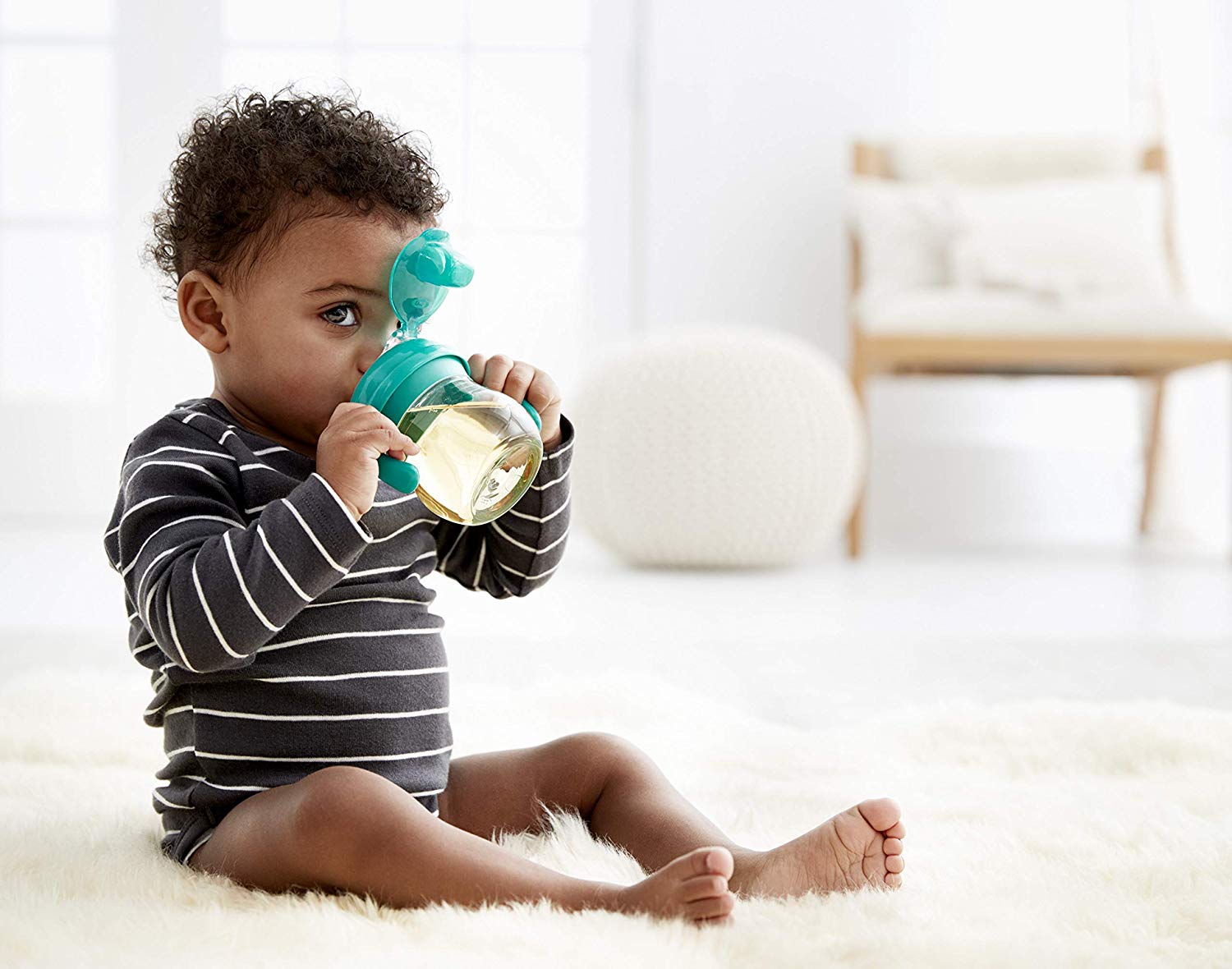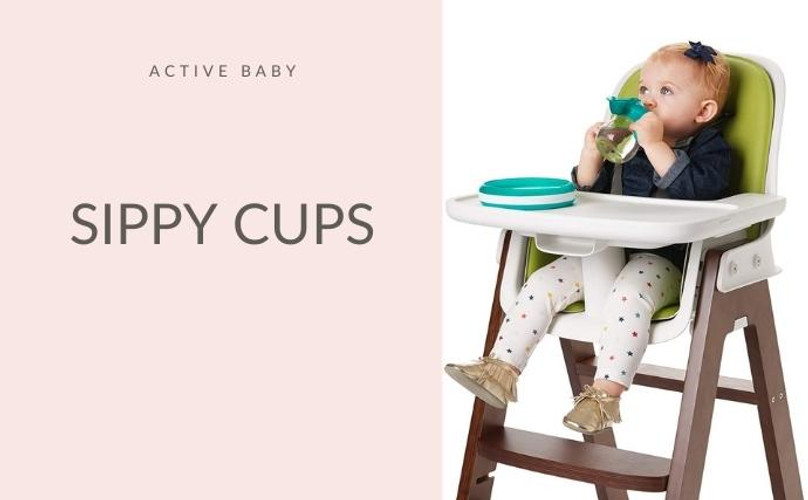Sippy Cups
Posted by Active Baby Canadian Baby Store Online on 2022 Jan 10th
Many little ones love their sippy cup, and just as many parents love them for the way they help avoid spills and messes. When is your baby ready for their first sippy cup and how do you introduce them?
By around six months of age, your child should be able to sit up straight in their highchair, indicating good neck control and the ability to move head and hands independently. This is usually an appropriate time for them to start using their first sippy cup and transition away from feeding exclusively by breast or bottle.

Although it is ideal to continue with the breast, it is advantageous for your child to begin moving away from the bottle, starting at around 9 months of age, leaving it behind completely by the time they reach their first birthday. Some of the reasons for breaking their bottle habit include:
Potential Increase in Tooth Decay
When your child remains dependent on the bottle, it may increase the likelihood of tooth decay. The mechanics behind drinking from a bottle versus a sippy cup means that their teeth are exposed to milk sugars for a longer period, increasing the risk of cavities.
Increased Likelihood of Obesity
Continuing to use a bottle for an extended period of time may result in obesity as the child grows older. Research has shown that those children who are still using a bottle by the age of 2 increase the likelihood of obesity by the time they are 6. This is typically a result of the child continuing to carry their bottle around with them, sipping on it throughout the day even though they have switched to a primarily solid diet and thus consuming too many calories.
There’s also the possibility of the opposite happening. Your child may become more resistant to eating solid foods and prefer to continue relying on their bottle for their nutrition.
The Bottle May Affect the Development of Teeth
There is some evidence showing that the constant sucking on a bottle causes the facial muscles to develop in a particular way, which can impact the development of the roof of the mouth and the eventual positioning of the adult teeth. As a result, the child may develop an overbite or crooked teeth, requiring orthodontics when they are older.
Transitioning to the Sippy Cup
So, now that your child is ready to move on from their bottle and start using their cup, how do you help them do so? Your child may feel attached to their bottle, and it may provide them with a feeling of security and comfort. Taking the bottle away will be a big change for them and might even feel a little bit scary, so unless your child seems eager to adopt a sippy cup, it’s probably wise to introduce it slowly rather than force a sudden change. Some ideas for gradual adoption of the cup include:
- Give them time to adapt and become familiar with it. Give them an empty sippy cup to play with before expecting them to drink from one. They’ll probably be more interested in the cup itself than its contents. Let them touch and hold it a little bit each day and they will come to view it as fun and familiar. When it’s time for them to start using it, they won’t have to adjust to both the cup itself and how to use it. They will already know the cup and likely have spent time with it in their mouth.
- Figuring out how to use the cup might take a little while, but learning is part of the fun. After your child has become familiar with the cup, you can introduce them to its true purpose by adding a small amount of your pumped breast milk and helping them learn how to hold the handles if they aren’t already aware. Teach them how to bring the spout to their mouth. Letting a drop or two of the milk spill out onto their lips will help them understand that something they know and love is waiting inside for them.
- Don’t rush things. You’ll have more success if you can keep things fun and stress-free. Many little ones are very attached to their bottle and/or their mother’s breast and will be resistant to change. You can start by offering their sippy cup for one feeding each day, letting them adapt at a slower pace. Over time, you can gradually increase the number of feedings using the sippy cup and they should be able to ease into it.
- Like almost everything else with your child, things will go much easier if you can make it fun. Babies learn through play and fun interactions with others, so be sure to show how happy and excited you are when they willingly start to use their sippy cup. If they are using it correctly, you can crank things up another notch. Your reactions will help them see that change is a good thing and that you are excited for them to learn new things. By the time your little one completes their transition to using the cup all the time, you may want to make a big production out of it. Time to celebrate.
More often than not, babies won’t want to switch from the bottles without some time, patience, and encouragement. You may have days or moments when your child is happy to use their sippy cup, only to find that they have changed their mind by their next feeding. Continue to make it fun and be patient while also offering encouragement. You may even want to offer a variety of different cups to make things more interesting and help them learn to hold different shapes and sizes comfortably.
Sippy cups are a great way to ensure that your child is staying hydrated while also avoiding spills and messes in addition to the loss of your breast milk or whatever they may be drinking.
Choosing a Sippy Cup
As with so many products for babies, there are many sippy cups available for you to choose from. Are all sippy cups the same? If not, how do they differ, and which is the best kind for your child? Here are some thoughts on what to look for when choosing a sippy cup for your child:
- Weighted on the bottom. A sippy cup that is weighted on the bottom will likely be sturdier and will also be less likely to tip over easily.
- Spill-proof. Even if your child is generally accepting of making the switch to a sippy cup, there are likely to be moments when they are not quite so enthusiastic about using it. At these times, you will likely find the cup becoming airborne, or at least pushed away and possibly tipping over. Having a spill-proof cup means less mess and not having to constantly mop the floor.
- Handles. Choosing a sippy cup with handles will make the cup easier for your little one to hold.
- Phthalate-free. BPA was banned from baby bottles and sippy cups in 2010 and cups and water bottles still tend to have packaging declaring that they are BPA-free, but not many of them mention phthalates. Canada has restricted the use of 6 phthalates in children’s toys and articles, but other phthalates are still not regulated.
- Spout. Sippy cups come with either a hard or soft spout. A soft spout will have a texture similar to a bottle, perhaps making it more appealing to your child, while a hard spout is resistant to teeth.
- Spoutless. Sippy cups without a spout are a newer option. They look like a regular cup, but with a lid. The cup has handles and can be turned upside down to drink but will seal to prevent spills when right-side-up.
- Valve or no valve? Many parents will express a preference for cups with a valve to make them spill-proof, but the valve also means the child will be sucking as opposed to sipping, at which point you are perhaps defeating the purpose of switching to a sippy cup.
How Long Do You Use a Sippy Cup?
Remember that just as you want your child to break away from the bottle and use a sippy cup, at some point you want them to move from the sippy cup to an open cup. This makes the sippy cup a transitional item that will be used for a limited time. Often, children will be able to move to an open cup by the age of two, when they have developed the necessary fine motor skills to use an open cup.
While sippy cups are convenient and can be quite useful, remember that your ultimate goal is for your child to start using open cups. When they appear to have the necessary control, it’s time to help them make the transition.


